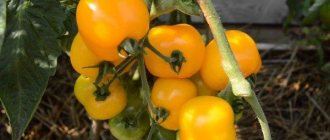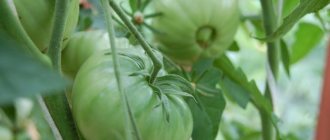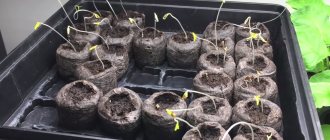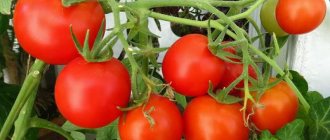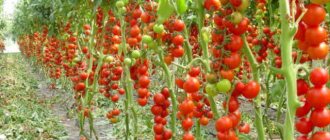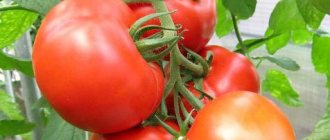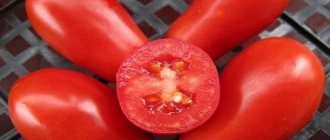Basic principles for creating beds in a greenhouse
Even a novice gardener can set up a greenhouse. After studying the main points, a person can easily grow not only tomatoes, but also other crops in the garden beds.
We focus on which side the light is on
The most suitable option for placing a greenhouse is from east to west. This approach provides the level of lighting that is necessary for tomato plantings. The greenhouse is placed in a lighted and open place.
Limited space does not affect the desire to plant tomatoes with different characteristics. Thus, summer residents combine shade-tolerant varieties with light-loving ones.
Plant height arrangement
It is recommended to plant tall plants closer to the walls of the greenhouse structure. Low-growing tomatoes are placed closer to the aisle. This combination is perfect for greenhouse conditions.
We take into account the design features of the greenhouse
Previously, glass or film was used to make greenhouses. But technology does not stand still, and the agricultural sector is constantly evolving. Glass and film have been replaced by polycarbonate. The material is easy to install, is reliable, unlike film, and is affordable, which cannot be said about glass.
If tomatoes are grown in a polycarbonate greenhouse, pay attention to such a parameter as height. Some varieties have the feature of uncontrolled growth in height
To ensure that the plants have enough space, greenhouses are made no lower than 2 m. Otherwise, the tomato beds will become cramped even at the initial stage of growth, which will negatively affect their fruiting.
How to plant a plant correctly
The scheme for planting tomatoes in a greenhouse directly depends on the variety of seedlings, as well as the method of forming its varieties. One of the main conditions for a good harvest is that the planting should not be too thick; each bush should receive the amount of sunlight it needs. Tomato seedlings are planted vertically, to a depth of no more than 3-4 centimeters. In the event that the seedlings are overgrown, there is no need to force the stem into the ground too much, this can have a bad effect on the amount of harvest.
As for how to place tomatoes in a greenhouse according to all the rules, agricultural specialists do not have a clear answer. Next we will consider the most optimal, in our opinion, placement scheme.
Planting of low-growing and quickly ripening varieties of tomatoes, formed in 2-3 stems, should be done in a checkerboard pattern in 2 rows, the distance between the bushes should be 50 centimeters, and between the plants themselves - 40 centimeters.
For seedlings of determinate and standard varieties of tomatoes, which are formed into 1 stem, the distance between rows is 50 centimeters, between bushes - 25 centimeters. It turns out that on 1 square meter it is quite possible to fit about 10 plants. However, with this method of planting, you need to carefully care for the plants so that they do not thicken, and you will need to use more seedlings.
Planting of indeterminate tall varieties of tomatoes occurs in two rows in a checkerboard pattern, the distance between the rows reaches 80 centimeters, and the plants themselves are at a distance of 60 centimeters relative to each other (if they are grown in 1 stem), and from 70 to 75 centimeters when grown into two stems.
But the best option is when planting tomatoes in a greenhouse in a combined manner. For this purpose, on each part of the greenhouse (in which there are two beds and a passage between them), seedlings are planted in two rows. The first row of tomatoes is planted near the glass - determinate, fast-ripening varieties, the distance between them should be 40 centimeters, while the tomato, as in the previous options, is formed into 1 stem. In the second row - the one located near the aisle - tall species are planted, with a distance of 60 centimeters, they are also formed into one stem. In the middle of determinate and tall tomatoes, seedlings of standard varieties are planted at a distance of 25 centimeters. They are formed into one stem and pinched after the 2nd cluster, on which 2-3 leaves remain.
When planting tomatoes in a polycarbonate greenhouse, experts advise slightly bending the roots of the seedlings so that they do not go too deep into the ground
This is important because the plant receives the bulk of all nutrients from the top layer of soil. If you bury the roots too deeply, you will deprive the tomatoes of the beneficial elements they need.
You should take this information into account if you do not want the seedlings to die and leave you without the expected harvest.
At the end of this article, I would like to remind you that gardening is a creative activity, you need to approach it exclusively with love and a good mood, and then no diseases or pests will be scary for your plants, and you will be able to get a good harvest of your loved ones as a result vegetables At the same time, you will be sure that they will be safe for the health of you and your loved ones - after all, it is you who control this process and can refrain from using a large number of harmful chemicals, which, although they help vegetables ripen faster, can carry with them various unpleasant consequences. Have a good (and healthy) harvest!
Basic planting patterns
When planting tomatoes in a greenhouse, the most compact arrangement should be provided, but at the same time, there should be sufficient distance between the bushes for normal cultivation. There are three main types of their placement:
- Regular. It is used if the greenhouse tomatoes planted have early fruit ripening. The distance between tomatoes in the greenhouse is 70 cm between beds, and between tomatoes in rows of 50 cm.
- Tape, two-line. This method involves planting two rows at a distance of 50 cm. In this case, tomatoes can be planted opposite each other or in a checkerboard pattern.
- Combined. This method is used when planting tomatoes of different varieties with different plant heights in one greenhouse. In this case, determinate tomatoes are placed near the walls with a distance of 40 cm between them, and the best placement of indeterminate seedlings is considered along the main path, leaving a space of 60 cm between them.
In the most popular and used greenhouses, measuring 6 x 3 meters, in which the main passage is in the center between two beds, it is optimal to plant tomatoes in the following quantities:
- Up to two hundred dwarf bushes and low-growing plants can be planted if you place 2 in one hole, and if you plant 1 tomato in each hole, you get 100 plants per greenhouse.
- It will be possible to place no more than 40 bushes of medium size, making several rows along the entire length of the greenhouse.
- If greenhouse plants are very tall, then it is better to plant tomatoes in a checkerboard pattern. No more than 30 of them can be planted in a greenhouse of this size.
See also
How to choose the best variety of tomato for pickling and canningRead
Very large varieties of tomatoes with spreading stems can accommodate no more than 25 plants.
Compatibility rules for tomatoes in a greenhouse
“Ataman”, “Lady’s finger”, “De-Barao”, “Kyiv 139”. How many varieties of tomatoes to plant in one greenhouse - let everyone decide for themselves. However, it is unlikely that any vegetable grower will limit himself to seeds alone, even if their pedigree has been verified over more than one season.
Let's consider four tomato planting schemes depending on the variety, as well as the location of the bushes relative to the greenhouse:
- Typical (the scheme provides for planting several varieties, as long as the height of all plants is the same);
- Practical (the cultivation is distinguished by placing cold-resistant tall tomatoes on the north side, so that the remaining rows, where medium- and low-growing tomatoes mainly grow, are definitely protected);
- High-yielding (the scheme requires the organization of a greenhouse with a height of at least two meters, since it is designed to combine several varieties of both determinate and indeterminate tomatoes with a long fruiting period);
- Combined (beds with tomato bushes are in close contact with other vegetable crops).
"On a note! The influences of the north side (relatively low light, cold wind) inhibit the development of plants, even if they are in closed ground. Accordingly, the greenhouse must be placed so that its edge and front face east-west. But the long side, which faces north, is better placed behind tall plants, a fence, or insulated with a triple layer of film. At the same time, it is preferable to plant tomatoes not across, but along the long walls of the greenhouse in order to obtain large yields and be able to densely “populate” the north of the greenhouse with tall tomatoes.”
Review of the best varieties of tomatoes for planting in a greenhouse
The following varieties of greenhouse tomatoes have proven themselves reliably:
- Major. Indeterminate high-yielding tomato. Fruits with dense pink pulp and a pleasant smell. The variety is resistant to both unfavorable conditions and diseases.
- Miracle of the earth. A high-yielding and early-ripening variety that is very popular among gardeners. The seedlings are tall, the fruits are heart-shaped and very sweet. Some tomatoes can reach a weight of up to 900 g. Plants are resistant to sudden temperature changes and drought.
- Gondola. Mid-season, indeterminate hybrid variety. The fruits weigh 150-500 g. The pulp is red and dense. Tomatoes have excellent keeping quality. They can be eaten fresh, salted, pickled, as part of side dishes and sauces.
- Kohawa. Ultra-early ripening and high-yielding variety. The tomatoes are flat round, weighing up to 150-180 g. The first fruits appear on the 90th day of the plant’s life. The seedlings are resistant to fungal diseases.
- Silhouette. High-yielding mid-early hybrid tomato. The fruits have an unusual rounded-flattened shape with excellent taste. The variety is resistant to unfavorable conditions.
- Dina. Mid-season productive variety. The seedlings are medium-sized, the fruits are round, large (150-200 g), very sweet, interesting bright orange color, rich in keratin. The variety is resistant to diseases and drought.
- Lelya. A recent discovery by breeders is an early ripening and high-yielding tomato. The fruits are small (up to 100 g) with bright red tasty pulp.
- Hurricane. An early-ripening, productive variety. The average weight of tomatoes is 80-90 g. Suitable for consumption fresh, pickled, or processed. The first harvest is harvested 85-90 days after planting.
- Long Keeper. Late high-yielding variety. The plant is of medium height, the fruits are large (up to 300 g), round. Tomatoes ripen well when stored.
- Bull's heart. A variety that has long won recognition among gardeners. Depending on the variety, it produces black, red and yellow fruits weighing up to 300 g, with juicy and fleshy pulp. The plant has record yields.
It’s better not to stop at one variety, but to grow ultra-early, mid-ripening and late-ripening ones so that you can have delicious tomatoes all summer long. When choosing a tomato variety, focus on the following characteristics: yield, shelf life, ripening time, taste, bush size, approximate weight, fruit size.
Tomato varieties
Planting tall tomatoes
Growing tall tomatoes allows you to save space in a greenhouse or open ground. To get a good harvest, you don’t have to plant a lot of plants, because up to 10 fruit clusters grow on one stem of this tomato. Tall tomatoes will not shade each other and will require less care. In addition, they can become a real decoration of a summer cottage, thanks to their elegant appearance.
If you grow tall tomatoes, the distance between rows can be up to 1 m, between bushes - 70 cm. In some cases, the interval can be slightly reduced: 70-90 cm between rows and 50-60 cm between bushes, respectively.
Here is an approximate diagram showing the planting of tomatoes, the distance between individual bushes and rows.
Remember that tall varieties of tomatoes require staking to a support.
5 ways to tie tomatoes How to tie tomatoes correctly in order to support tall bushes and not lose the harvest of large fruits?
What should be the distance between tomatoes when planting?
Tomatoes are one of the most favorite crops cultivated by Russians on their plots. One of the important conditions for obtaining a high-quality harvest is the distance between tomatoes when planting them in the ground in a permanent place.
Tomatoes are a crop that likes moderate soil moisture, and if you don't give them the right amount of water, the yield will be much less than what the plant is capable of producing. Therefore, in order to maintain the required soil moisture, agronomists advise planting seedlings in trenches dug to the width and depth of a spade bayonet.
Before planting, the trenches are well moistened with several buckets of water. Strong seedlings are planted in wet trenches, sprinkling the roots with a small amount of soil. Depending on the height of the seedlings, you need to choose the optimal distance between the tomatoes in the trench. For low-growing varieties it can be within 40-50 cm, and the distance between the trenches is 50-70 cm.
There is no need to put soil between the tomato bushes. After planting all the tomatoes, the trenches need to be filled to the top with mowed grass and tamped down a little. As the grass dries and subsides, you need to add a new portion several times.
Watering for tomatoes in trenches is needed much less often than with the usual method of planting seedlings in holes. Moisture in trenches is stored much longer, which means you can expect not only a larger harvest, but also less hassle associated with watering.
This method of planting tomatoes in trenches will help you get relatively large yields of your favorite vegetable, without particularly straining in terms of regular watering.
OgorodSadovod.com
Soil preparation
Regardless of which greenhouse you plan to plant tomatoes in, one of the most important indicators of a good harvest is well-prepared soil. This is one of the significant advantages of the greenhouse method of growing tomatoes compared to planting them in open ground - because here you have the opportunity to independently prepare the most suitable soil composition for the growth of vegetables.
As a rule, a greenhouse is installed on a site and the soil that is located on it is used for it. But if you want to achieve high yields of tomatoes, you will have to carry out work to improve the soil.
The soil for planting tomatoes should be loose, light and have good breathability.
In the process of preparing the soil, you should be guided by the following recommendations:
- In the case of clay or loamy soil, in order to improve its structure in the greenhouse, it is necessary to fertilize it with a bucket of humus, peat and sawdust (a bucket per 1 square meter).
- When the site mainly consists of peaty soils, you should add a bucket of small shavings, humus and turf soil, as well as half a bucket of coarse sand per square meter.
- If chernozem predominates in the greenhouse, a bucket of humus and half a bucket of coarse sand are added per square meter.
In addition to organic fertilizers, it is also necessary to use mineral fertilizers - if you adhere to the specified dosage, they will be very beneficial for the plants and will help you get a good harvest of tomatoes. It will be enough to add 1 teaspoon of ammonium nitrate and 3 teaspoons of superphosphate per square meter of soil. If possible, you can additionally add 1-2 tablespoons of wood ash (it contains many useful microelements that are easily absorbed). After all these manipulations, the beds should be dug well and the soil in them should be loosened.
Agronomist experts do not recommend planting tomatoes in the same soil for several years in a row. This is explained by the fact that pests and diseases can survive in the soil for a long period of time, and they will nullify all your efforts to get a good harvest of tomatoes in a polycarbonate greenhouse.
If possible, the best solution would be to build two greenhouses at once and plant tomatoes and cucumbers in them alternately: one year you plant tomatoes, and the next year you plant cucumbers. If there is only one greenhouse, the tomatoes should be planted in the place where cucumbers grew last season; it is first necessary to remove 10-12 centimeters of the top layer of soil from the bed, this way the seedlings are protected from damage to the rhizomes by rot.
When replacing the top layer of soil, it should be disinfected; for this purpose, a hot solution of copper sulfate is used at the rate of 2 tablets of oxychome per ten liters of water.
Preparing a greenhouse for planting tomatoes
Before moving tomatoes, you need to properly prepare the greenhouse
How to prepare the soil for planting tomatoes
Typically, greenhouse soil is changed once every five years. During this time, it manages to be completely depleted, even if fertilizers were applied regularly.
The first step in the fall is to disinfect the greenhouse substrate using improvised means:
- A solution (1%) of Bordeaux mixture.
- Suspension (1%) of copper sulfate.
- Dolomite flour (50 g per 1 m²).
Then we start preparing the land:
- The lower insulating layer is installed - first a 10-centimeter layer of sawdust, dry pine needles or straw. On top is another 10-centimeter layer of rotted compost.
- The insulating bedding is filled with garden soil - a high ridge 30-40 cm high is obtained.
- If the ground is turf, fertilizers are applied during digging (per 1 m²): 3 tbsp. spoons of superphosphate in granules, 1 tbsp. spoon of potassium magnesia, 1 tbsp. spoon of potassium sulfate, 2 tbsp. spoons of ash, 1 teaspoon of urea (replacement - sodium nitrate).
- If the soil is clayey or loamy, an additional bucket (per 1 m²) of peat, humus and crushed sawdust is required.
- If the substrate is peat, additionally add (per 1 m²) 1 bucket of turf, humus, wood shavings or sawdust, and ½ bucket of coarse sand.
After such procedures, the greenhouse is completely ready for the spring transfer of seedlings.
Temperature
Tomatoes can be transplanted into a greenhouse when the temperature is set:
- Priming. Not lower than 13 °C at a 10-centimeter depth.
- Air. 20-25 °C.
If your greenhouse is heated, these conditions can be created artificially at any time - plant seedlings in early spring and eat fresh tomatoes until late autumn.
At what distance can tomatoes be planted in a greenhouse?
At what distance to plant onions?
When planting seedlings in a greenhouse, you need to remember that during the entire period of growth, fruiting and harvesting, tomatoes need to create comfortable growing conditions. The entire season requires watering, weeding, feeding, planting, spraying and hilling the bushes. That is, it is necessary to provide free access to each plant.
To provide the best conditions for the growth and development of tomatoes in a greenhouse, it is necessary to comply with the established rules and conditions, one of the main ones is the use of a certain planting pattern: planting tomatoes at a certain distance between the bushes. The frequency of planting bushes depends on the variety.
If certain planting patterns are followed, obvious advantages appear:
- prevention of pests and diseases, the likelihood of which increases with dense plantings;
- supplying tomatoes with sufficient area for development;
- ease of care for tomato plantings, ease of performing all necessary procedures (watering, fertilizing, etc.).
Correct landing distance
The distance between the bushes when planting seedlings is determined by the type of tomatoes, there are three of them.
Low-growing or standard:
- plant height does not exceed 50 cm;
- the root system is compact;
- thick strong trunks;
- no garter needed.
Low-growing or standard
Low-growing varieties are planted with 6 - 7 bushes per square meter.
Medium-sized (determinant):
- height up to 1.5 m (the plant itself limits growth);
- it is necessary to form a bush;
- Plant 3 - 4 bushes per square meter.
Medium-sized (determinant)
Tall (indeterminate):
- intensive growth;
- height more than 3 m;
- need gartering, pinching, pinching.
Tall (indeterminate)
On a note. No more than 2 bushes are planted per square meter.
There are several technologies for planting seedlings.
The most common is planting in rows. With this method, markings are made and seedlings are planted in rows. This method requires large areas, which is not suitable for greenhouses.
When planting in parallel, two rows are made between the aisles, which saves space while maintaining ease of plant care. This way you can plant any variety, regardless of the height of the bushes. The distance between bushes in a row ranges from 60 to 65 cm, between rows - 25-45 cm, depending on the height of the bushes. The passage between the beds is left 80-100 cm. This scheme is used when planting seedlings in a greenhouse.
On a note! Some shading of the bushes is considered a disadvantage of this method.
When planting short and tall varieties at the same time, a combined planting scheme is used, when tall varieties are planted in the center of the bed, and short varieties are planted along the edges, which provides free access to any bush. Space is saved, the method is suitable for greenhouses.
What determines the scheme for planting tomatoes in a greenhouse
Tomato plants react painfully to thickening; it not only reduces the feeding area, but also impairs lighting and ventilation. And this, in turn, contributes to the development of various diseases and even plant death. Therefore, it is so important to organize the correct planting scheme, which is determined by the following parameters:
- tomato variety (or combination of varieties);
- bush type (formation method);
- growing season;
- dimensions of the plot or greenhouse;
- type of protective structure.
How many bushes can you plant, at what distance and how to do it correctly?
- The polycarbonate greenhouse should be well lit so that the plants do not stretch out.
- It would be good if there was a drip irrigation system with warm water. You can install a tank in the greenhouse in which the water will be heated and settled.
- Ventilation required.
- Insulate the soil with hay or straw to prevent the return of frost.
- Make holes 20 cm deep at a distance of 30-50 cm.
- Pour 1-2 liters of water into each.
- Place the seedlings in the holes, early varieties - 2 pieces in each, late varieties - one at a time.
- Fill the hole with soil and compact the soil.
- Trim leaves that touch the ground.
Despite the fact that the conditions in the greenhouse are more comfortable, before planting, tomatoes must be hardened by taking them outside, gradually increasing the time.
Schemes for growing vegetables in greenhouses of various sizes
3x4
For greenhouses measuring 3x4, a two-line or three-line tomato planting scheme is used. Low-growing varieties are planted, as a rule, according to a two-line scheme.
In a 3x4 greenhouse you can place 132 or 78 bushes, depending on whether you plant one or a couple of them in one hole.
Mid-season and hybrid varieties are planted in two rows per bed. This makes about 24 bushes. Tall varieties are planted in two rows in a checkerboard pattern. In such a greenhouse, 20 bushes will be comfortable.
3x6
In a greenhouse with a layout of 3 by 6 meters, a two-line or three-line tomato planting scheme is used. A comfortable number here would be 200 bushes if you plant 2 in one hole, or 120 if you plant each bush separately.
How many tomatoes can you plant in a 3 by 6 greenhouse? There will be 40 bushes of medium-sized tomatoes. High varieties - 32 bushes.
For your information. Tree-like plants require at least 100 cm of free space, and therefore in a greenhouse of this size, 14 of them can be planted in 2 rows.
3x8
An interval of 30-50 cm wide is usually made between plants, which means that if you plant 3 rows of 2 bushes in each hole, you will get 264 pieces. If each plant has its own hole, there will be 162 of them.
Medium-sized species are planted in 2 rows with an interval of 50 cm. Thus, there will be 52 tomato bushes. Tall varieties are planted in 2 rows in a checkerboard pattern at a distance of 70 cm from each other. You will get 44 bushes. It is better to plant tree tomatoes at a distance of 1 meter between plants. There will be 18 of them in two lines.
Technologies
Double row
Suitable for standard and determinate types of tomatoes that are planted in rows. The distance between plants is from 25 to 40 cm.
Chess
The distance is about 60 cm between bushes, and 80 cm between rows. For determinate types of tomatoes, this scheme is also suitable. Then 50 cm are measured between the holes if there are three stems, and 30 cm for bushes with one stem.
Features of placement in a greenhouse
It is important to pay attention to organizing a comfortable microclimate in a polycarbonate greenhouse. One of the favorable conditions for growing is the correct planting of tomatoes in a greenhouse area, so that the bushes are fully provided with light and access to oxygen.
With proper planting, tomatoes will not lack nutrients entering the soil - this will allow them to grow, develop normally and produce good fruit. If you want to reap a good harvest, you need to plant them correctly and take good and systematic care of them.
See also
The best varieties of tomatoes for the Kirov region in a greenhouseRead
There are three possible placement options (the choice must be made based on the tomato variety):
- The traditional scheme is used for early ripening varieties. The distance between rows should be 0.7 m, and between bushes - 0.5 m.
- Ribbon - characterized by plants arranged in a checkerboard pattern. The distance between bushes is 0.5 m.
- A combined scheme is used for growing different varieties. Low ones are located along the walls (at a distance of 0.3–0.4 m from each other), and high ones are planted near the aisle (at a distance of 0.5–0.6 m).
The greenhouse is placed from east to west - this will provide the necessary lighting.
It is important to know how many tomatoes can be placed in a 3x6 room:
- low-growing varieties - plant about 200 pieces, 2 bushes in one hole;
- varieties are medium in size - about 40 pieces are planted;
- tall varieties - plant about 30 pieces, in a checkerboard pattern;
- very large varieties - placed in one line of 10 - 14 pieces.
If several different types of varieties are planted, it is necessary to calculate the optimal amount of planting material in the greenhouse so that the error does not affect the harvest.
Advantages of growing tomatoes in a greenhouse
But first, a few words about the advantages of “closed” growing:
- the possibility of early sowing and transplanting seedlings;
- increase in productivity;
- early product release;
- stable and optimal microclimate (temperature, moisture);
- preventing the proliferation of harmful insects and the development of diseases;
- frost protection;
- protection from the sun, precipitation and industrial emissions;
- simplicity of conveyor care;
- convenience of selection for the purpose of obtaining new hybrids.
In general, the listed features apply to many vegetable and even garden and berry crops: eggplants, cucumbers, peppers, herbs, strawberries, etc.
For personal consumption and small trade, the vegetable grower chooses something between tomatoes and cucumbers or, as a rule, plants several crops in close proximity to each other in a greenhouse.
How to calculate planting density for a 3x6 greenhouse
Having finally decided on the choice of a specific scheme and knowing the dimensions of the greenhouse (3x6 m), it will not be difficult to calculate the planting density and the number of tomatoes that can be placed there. Usually in such structures they make two long longitudinal beds along the edges and one in the center. If you put 2 lines in the central bed, and one in the outer ones, you will get 4 rows in total. Through simple calculations, it turns out that about 14-20 pieces of low-growing tomatoes can fit in a line, and no more than 9-10 pieces of larger ones. As a result, the total number of plants, according to this scheme, in the greenhouse will be around 56-80 or 36-40. The planting density in the case of compact varieties will be about 3-4 tomatoes per 1 m2. You cannot plant more than 2-3 tall tomatoes per 1 m2.
The entire area of the greenhouse can be planted as usefully and efficiently as possible by wisely choosing a planting scheme, always taking into account the individual varietal characteristics of the tomatoes used. In this case, all the tomatoes will feel comfortable indoors, without experiencing any inconvenience, as well as a lack of light or essential nutrients. The potential capabilities of the variety will be fully utilized, and the return of a generous vitamin harvest is guaranteed.
How to calculate the required number of bushes
After ensuring a comfortable microclimate in the shelter, they think about the number of bushes planted in the beds. People are always interested in the question of how many pieces should be planted in a greenhouse. It all depends on the type and variety of crops.
Dwarf and short
Tomatoes with short stature are usually planted in a hole with 1 or 2 bushes. The distance between the holes does not exceed 40 cm. In this case, the number of bushes reaches 150-200 pieces. In the future, only strong seedlings are left.
Medium height
Hybrid representatives of tomatoes are most often placed in two lines in greenhouse beds. The distance between the bushes is from 45 to 50 cm. There are no more than 40 plants in one line.
Tall
Plants of this type are recommended to be placed in a checkerboard pattern. Two lines are made on the prepared bed. The maximum number of bushes is 30-33 pcs.
Spreading
Some tomato varieties tend to clutter up a lot of space with their large vines. Such varieties are called spreading. They are planted in one line of 10-13 bushes.
Why do you need to keep the recommended distances?
Unfortunately, gardeners often save space in the garden bed, in the greenhouse or in the seedling box and do not pay attention to the correct distance to plant tomato seedlings. This vegetable does not tolerate crowding, which can lead to the following problems:
- in a very dense neighborhood, tomatoes will cast a shadow on each other and this will slow down their development and reduce fertility;
- A short distance will also have a negative impact on the root system: more powerful plants will begin to suppress weaker ones, taking away moisture and nutrients;
- seedlings will be more susceptible to various diseases, which, due to their close proximity and impaired air circulation, will be able to quickly cover one bush after another.
Planting tomatoes at an unreasonably large distance will not solve the problem, because in this case the vegetable plantations will occupy significant areas of land. Therefore, the distance between the rows and the plants in them is an important point, both when sowing seeds and when planting seedlings.
Planting tomatoes in greenhouses
At what distance should tomatoes be planted in greenhouses, the main importance is what variety is chosen for cultivation and what size bushes these plants have. When using medium-sized plants, a row spacing of 70 cm should be left between them, and for low-growing plants - about 60 cm, between bushes with tall stems 50 cm, and for small ones, 40 cm is enough.
The distance left is also influenced by the forming methods and planting patterns used. If you plant tomatoes with a large main stem, you can leave 20-30 cm between the bushes. If such plants are planted in groups of 2. in one hole, then leave 35-40 cm between two holes.
The height of the structures is selected in such a way that at least 50 cm remains above the tomatoes in the greenhouse. The width of the greenhouses should be 1 meter larger. This will create optimal conditions for bush growth and fruit ripening.
A planted tomato in a hole is equally distant from other plants. The height of the beds is 30-35 cm, and there is a gap of 40-45 cm between them. After the formation of the bushes begins, they are further deepened into the ground. To do this, new soil is added to the formed beds. This strengthens the main stem and prevents the bushes from falling to the side.
At what interval from each other should I plant?
Planting tomatoes in a greenhouse is associated with limited space and space saving. When planted too closely, the plants get sick, they lack light, and the yield per bush decreases.
Planting tomatoes at too great a distance from each other is also irrational - it uses up excess space in the greenhouse.
To choose the optimal tomato planting scheme, you need to know what variety and type of seedlings are planted in the greenhouse soil. All information about the tomato variety is indicated on the seed packaging.
Important. According to the general standards for planting tomatoes in a greenhouse, 2 stems are formed for low-growing and early-ripening varieties, the distance between bushes is 35-40 cm, between rows 50-60 cm.
For tomatoes formed into one stem, the space occupied is less: the distance between bushes is 25-30 cm, row spacing is 45-50 cm. For tall ones, 60-70 between plants, with row spacing of 75-80 cm.
What influences placement
As a rule, gardeners plant several varieties of tomatoes in a greenhouse. However, some other criteria also influence the scheme:
- The direction of the wind affects temperature regulation and the presence of drafts in the room. Thus, tomatoes with poor resistance to temperature changes are best planted against the walls of the greenhouse.
- Lighting. There are varieties that need a lot of light. They must be placed on the sunny side.
- A combination of different varieties. In a small space, it is more profitable to plant tomatoes with a variety of characteristics. For example, you can combine light-loving varieties with shade-tolerant ones.
- The level of amenities is an important factor in choosing an accommodation option. This includes the location of greenhouse beds, the design of irrigation systems, lighting, heating and ventilation.
How does the tomato variety influence the choice of planting scheme?
Breeders produce both short and tall tomatoes. The interval between bushes that have an unlimited growth point cannot be the same as when planting standard or dwarf tomatoes.
Indeterminate
In tomato varieties that have powerful roots, shoots reach 3 meters in height during the growing season. Indeterminate hybrids cannot be placed close to each other, per 1 square meter. Only 2 plants are planted. The bushes need to be tied to a support, the stepsons should be torn off, and the stems should be pinched.
Determinant
Tomatoes 1.5 m high have developed roots, but grow only to a certain point. Varieties that do not require formation are placed on 3 or 4 bushes per square meter.
Low-growing, standard
The height of these compact tomatoes is less than 0.5 m. Tomatoes are distinguished by strong and thick stems, densely leafy branches that are not tied to a support or shoots. For 1 sq. meter can hold up to 7 standard tomatoes.
Growing seedlings and planting in greenhouse beds
The prepared containers are filled with soil substrate, compacting it. It is necessary to make grooves in the soil (1-1.5 cm deep). The ground is watered with warm sodium humate hydrate and the seed is distributed evenly. Sprinkle the soil mixture over the furrow. Planting containers are placed in a sunny place. The room temperature should be +22°C. The planting is covered with polyethylene or glass.
After 2 true leaves appear (7-10 days after sprouting), pick them into a large container. Using a toothpick, each sprout is removed along with a lump of earth and transferred to large containers. Seedlings are kept in boxes for no longer than 50 days.
The seedlings are transplanted into greenhouse conditions when 8-12 leaves and 1-2 inflorescences appear on the stem. 2-3 days before moving to the greenhouse, the bushes are prepared: 2-3 lower leaves are torn off, leaving rather long stumps (15 mm). The measure will reduce the crop’s exposure to disease and improve air circulation. The plantings will be evenly illuminated.
Choosing a greenhouse
Since the majority of vegetable growers only have a few acres, they have to plant tomatoes in a small greenhouse quite often. The most optimal solution in this case is a 3x6 meter frame structure, which is covered with film or, even better, polycarbonate. Based on its size, it is not at all difficult to calculate how many tomatoes you can plant in total - 32-60 bushes.
"On a note! When choosing a greenhouse structure, you need to pay attention not only to the size, but also to the strength of the frame, the presence of a ventilation window and even a design bed. The last element eliminates the need to think at what distance to plant tomatoes in the greenhouse."
As a rule, reinforced greenhouses of the appropriate area cost no less than 18,000 rubles. Regarding the supply of high-quality structures for creating protected soil, the following manufacturing companies have proven themselves well:
- "Volga Greenhouses";
- "Factory of ready-made greenhouses";
- "The World of Greenhouses"
- "Garden of Eden";
- "Greenhouses of the North";
- “Greenhouse choice”, etc.
Why is it better to grow tomatoes as seedlings in a greenhouse?
There are many reasons for growing tomatoes in greenhouse conditions:
- Possibility of harvesting ultra-early and late harvests - from early spring to late autumn.
- Growing tall bushes that do not take root well in open ridges. It is these seedlings that produce large fruits up to 0.5 kg.
- The possibility of planting productive heat-loving varieties that do not do well in harsh Russian conditions.
Greenhouse plants do not require additional care - all activities are simple and familiar, even a beginner can do it.
Tall tomatoes in a greenhouse
Greenhouse operation
In order for the operation of the greenhouse to occur at the highest level, the thematic design must first be organized, guided by the following factors.
- Specifics of the region (climate, soil quality);
- Timing of sowing, planting seedlings and harvesting (extra-early, traditional, year-round);
- Volume of required harvest (private, commercial);
- The purpose of the growing season (for seedlings, to obtain ripe fruits);
- Organization of planting material (planting scheme);
- Features of the crop (variety, vegetation, hardening, bush height).
"On a note! When buying tomato seeds, on the label you can see such strange definitions as “determinate”, “indeterminate”, “standard”.
In particular, we are talking about the classification of varieties according to growth and ovary formation:
in determinate tomatoes, the ovary begins above 3-6 leaves, and ends after the formation of 5-7 clusters;
standard tomatoes have limited growth, so they have a fairly thick and strong stem up to 0.5 meters high, which can be seen even when looking at tomato seedlings;
in indeterminate varieties, the first ovary is formed above 6-8 leaves, and each subsequent one occurs continuously, every 3-4 leaves.”
Scheme of planting and arrangement of tomatoes in a 3x6 greenhouse, quantity
Seedlings are young tomato shoots that eventually mature into adult crops.
In order for this process to go correctly and give the desired result, gardeners pay attention to the space in the greenhouse. Thoughtful organization of space in the shelter facilitates maintenance and increases productivity
For this purpose, gardeners actively use a scheme for planting tomatoes in a 3x6 greenhouse.
Basic principles for creating beds in a greenhouse
Even a novice gardener can set up a greenhouse. After studying the main points, a person can easily grow not only tomatoes, but also other crops in the garden beds.
We focus on which side the light is on
The most suitable option for placing a greenhouse is from east to west. This approach provides the level of lighting that is necessary for tomato plantings. The greenhouse is placed in a lighted and open place.
However, the greenhouse may have partial shade or full shade on certain sides. In this case, varieties that need a lot of light are placed on the sunny side.
Limited space does not affect the desire to plant tomatoes with different characteristics. Thus, summer residents combine shade-tolerant varieties with light-loving ones.
Plant height arrangement
It is recommended to plant tall plants closer to the walls of the greenhouse structure. Low-growing tomatoes are placed closer to the aisle. This combination is perfect for greenhouse conditions.
We take into account the design features of the greenhouse
Previously, glass or film was used to make greenhouses. But technology does not stand still, and the agricultural sector is constantly evolving. Glass and film have been replaced by polycarbonate. The material is easy to install, is reliable, unlike film, and is affordable, which cannot be said about glass.
If tomatoes are grown in a polycarbonate greenhouse, pay attention to such a parameter as height. Some varieties have the feature of uncontrolled growth in height
To ensure that the plants have enough space, greenhouses are made no lower than 2 m. Otherwise, the tomato beds will become cramped even at the initial stage of growth, which will negatively affect their fruiting.
Beds for protected soil
Brick, slate and wooden boards were previously used to create the sides. Each of these materials has its own disadvantages:
- the tree quickly becomes unusable;
- slate is a material that cannot boast of environmental friendliness;
- installing bricks takes a lot of effort and time.
Relatively recently, galvanized sides were introduced to the market. They have no analogues in terms of characteristics. The material is durable and strong. It is not afraid of moisture and increased temperature in the greenhouse. They can be assembled and disassembled and are not affected by fungus.
Schemes and technology for planting bushes
If a person seriously approaches the issue of organizing optimal conditions for growing tomatoes in a greenhouse, he will consistently receive a good harvest. Nutrients in the soil support the normal development of tomatoes. In turn, this affects the fruits. Few people think that proper planting in a greenhouse affects crop yields.
Gardeners often use two placement options - two-row and checkerboard. The choice of one of them depends on the varieties that will be planted. There is also a third method - combined, but it is used quite rarely.
Double row
This is a traditional pattern for planting crops such as tomatoes. Used exclusively for early ripening tomatoes. The distance between the bushes is 50 cm. The free space between the rows is 70-75 cm.
Chess
It is called a ribbon plant, the bushes of which are arranged in a checkerboard pattern. People who decide to plant tomatoes according to such a scheme will only benefit. The distance between the bushes is small - only 45-50 cm. Arranging the bushes according to this pattern ensures ease of care and easy harvesting.
Watering and fertilizing are not all the procedures on which the normal growth and development of tomatoes depends. Proper organization of space is the basis, and further care of the plantings depends on it. The optimal dimensions of the greenhouse are 3x6 m. Such indicators allow you to plant tomatoes in checkerboard and two-row patterns. If desired, a combined method of planting tomato bushes can also be used.
Greenhouses measuring 3 x 6 and the location of tomatoes in them
The most functional are structures that are easy to install - these are greenhouses with a size of 3 x 6 m. You can place bushes in them with a distance of 30 cm, and leave a row spacing of 50 cm. The optimal requirements at what distance is better to plant tomatoes in such greenhouses are:
- Organization of beds with a direction from the east side to the west.
- Laying in greenhouses with low-height beds in one row with a width of 35 to 40 cm, located under the walls of the greenhouse. In this case, a distance of 40 cm is left between plants.
- Formation of two rows in the central part. Tomatoes are planted on them in a checkerboard pattern. The distance for low-growing plants is 40 cm, and for tall plants it is 65 cm.
- At least 85 cm is left between the beds of tall bushes, and 50 cm for low-growing bushes.
To optimize the use of the greenhouse area of 3 x 8, the number of medium-sized bushes is up to 45 plants, and tall, with numerous stems and tomato trees, no more than 15 pcs.
To improve the preservation of the thermal regime in greenhouses, a multi-layer coating can be made. This is especially true on cool nights in May. Leave 5 cm between the layers of film. This method, in addition to maintaining the necessary thermal conditions inside the greenhouse, will also ensure a longer period of use of the coating.
See also
Review of super-determinant tomato varieties for greenhouses and open groundRead
After June 1, the top layers can be removed. To ensure ventilation of the air flow, vents must be provided . Loamy and sandy loam soils are chosen as soil. The time for planting seedlings in a greenhouse should begin when the temperature at a depth of 15 centimeters reaches +14 degrees. To maximize soil warming, cover it with black plastic film.
Dates for planting in the greenhouse
It is important not to make a mistake with the timing of transplanting seedling bushes into greenhouse conditions. Tomatoes are transferred to a heated glass structure in late April.
If there is no heating in the film shelter, then planting is carried out in early May. In other situations, the disembarkation time falls at the end of May.
Depending on the region
In different regions, the time frame for transferring tomato bushes to artificial shelter varies greatly:
- in the Moscow region - in the spring from the last days of April to May 15;
- in St. Petersburg and the region - in May (from the 15th);
- in Siberia and the Urals - from May 15.
It is important to focus on the degree of heating of the soil and air. The earth should warm up to +8-12⁰С, the air - to +15⁰С
When to plant tomato seedlings in a greenhouse: optimal timing of transplantation
Seedlings are planted in a greenhouse several weeks earlier than in open ground beds. This is due to the fact that greenhouse conditions are milder and more suitable: the temperature is higher than outside, the soil and air warm up faster. Such conditions and earlier planting allow you to enjoy the harvest earlier.
Important! You can plant seedlings in a greenhouse only after the soil temperature is above 12-15 degrees Celsius and the air temperature is above 15 degrees. At the same time, at night the air temperature should not fall below 8 degrees!
When to plant tomato seedlings in a greenhouse? It is impossible to name exact and universal deadlines for all greenhouses in our country, because weather and climatic conditions differ significantly in different regions. In general, the growing region and the type of greenhouse structure play an important role:
- in the central zone (including the Moscow region): in a heated greenhouse - optimally plant in the second half of April;
- in a polycarbonate greenhouse - in early May;
- in a film greenhouse - in the second half of May.
- in a heated greenhouse - optimally planted at the end of April or at the beginning of May;
Note! Despite the desire to get early, tasty, sweet and juicy tomatoes, you should not rush and replant tomato seedlings ahead of schedule. Otherwise, under unfavorable conditions (in particular, low soil and air temperatures), the plants will take a long time to recover and grow slowly, therefore, one cannot even think about any early harvest of tomatoes.
At what age can seedlings be planted?
An important guideline when choosing the timing of planting is the stage of its development (that is, age). The approximate age when plants can be planted in a greenhouse is 50-70 days after germination. By this time, the plants should have developed a developed and strong root system and strong shoots.
Suitable planting dates are also determined by the appearance of the plant: the height of one plant is about 20-30 centimeters, the thickness of the stem is 0.5-0.7 cm, there should be 6-10 true leaves.
Landing dates according to the Lunar calendar 2021
It is believed that the cycles of the moon can determine both suitable and undesirable times for the procedure. So, we can distinguish the following dates for planting tomato seedlings in a greenhouse according to the 2021 Lunar calendar:
- Favorable days: in April: 15th, 17th;
- in May: 13, 14, 15, 16, 17;
- in June: 11, 12, 13, 14, 15.
- Unfavorable days (that is, on these dates it is better to refrain from the procedure): in April: 11, 26;
- in May: 11, 26;
- in June: 10, 24.

